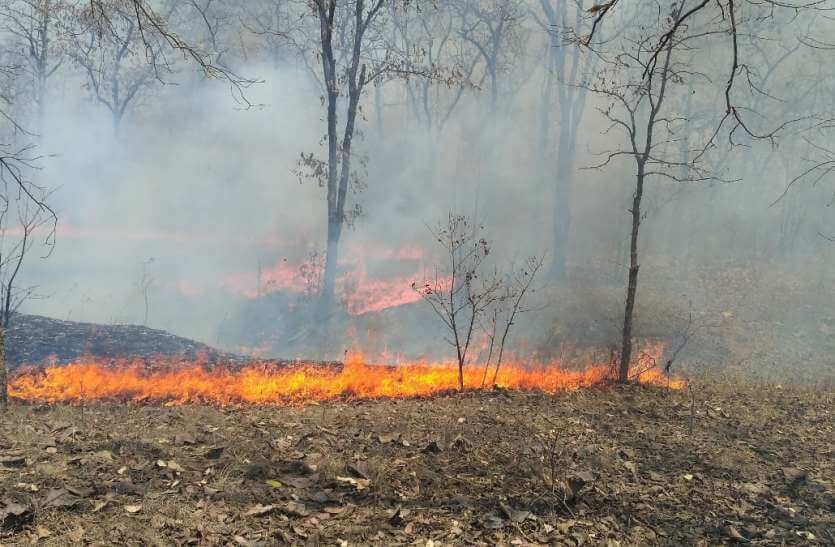Forest is one of the most important renewable natural resources and plays a significant role in the human life and environment. In 2017, the maximum number of forest fires were reported in Madhya Pradesh (4,781) followed by Odisha (4,416) and Chhattisgarh (4,373). In the same year, there were 260 recorded incidents of forest fires in Rajasthan. The fire season in the state is from January to June. Peak fire season in the month of May.
Types of Forest Fires:
Forest fires can be sub grouped into four types depending upon their nature and size:
- Surface Fires:
- Surface fire is the most common forest fires that burn undergrowth and dead material along the floor of the forest.
- Underground Fire
- Fires of low intensity, consuming the organic matter beneath and the surface litter of forest floors
- Ground Fires
- Fires in the sub surface organic fuels and organic soils of swamps or bogs.
- Crown Fires:
- Crown fire is the most unpredictable fires that burn the top of trees and spread rapidly by wind.
Causes of Forest Fires in Rajasthan
More than 90% forest fires are caused either by negligence or unknowingly by the human being. The rest of the fires are caused by natural reasons i. e. lightning, extreme rise in the temperature etc.
Climate Change
Studies suggest that climate change influences forest fire frequency and intensity which results in forests becoming increasingly inflammable. The increasing duration of forest fire season, numbers of large fires, frequency of severe fire years may be related to climate change.
Traditional Customs
As per tradition, local tribals go on a forest-burning spree after the Holi festival. Example, tribal customs like ‘Magra Snan’ i.e offering fire to please ‘Magra Bavji’ or the Hill God upon accomplishment of any wish.
Human negligence
Unwanted forest fires may also occur due to human negligence, for example, from casually discarded cigarettes or from poor control of burning on adjacent croplands.
Weather
Fire intensity and behavior are intricately linked to weather and climate. For most of India, forest fires peak during the dry months of March or April before the arrival of the monsoon (FSI 2012).
Impact of Forest Fires
Some forest fires are beneficial, but not all. Occasional fires can also keep down fuel loads, check invasive weeds, and eliminate pathogens. However, majorly forest fires have a devastating or degrading effects. Few of these are:
- Loss of natural vegetation and reduction of forest cover.
- Loss of wildlife habitat and depletion of wildlife.
- Repeated fires in short succession reduce species richness and hamper natural regeneration ability.
- Monetary damages in terms of loss of timber resources.
- Forest fire also adversely affects livelihood resources, especially for tribals, who habitat within or near the forest.
- Loss of environmental services.
- Fires alter the physical, chemical, and biological properties of forest soils. Higher-intensity fires can severely deplete soils and strip them of organic matter and nutrients. Fires increase water repellency of forest soils, reducing infiltration and increasing erosion.
- Forest fire release multiple gases back to atmosphere in a matter of hours. The burning of forest also destroys an important sink for atmospheric carbon dioxide and aggravate global warming
- The smoke from forest fires cause air pollution and rise in the temperature which leads to adverse impact on Health system.
- Forest fire that spreads outside the forest can consume buildings or infrastructure and cause threat to Life and Property
- Forest Fires pose a risk to policy goals for enhancing India’s forest carbon sinks.
Forest fire area in Rajasthan
As per ISFR 2019-Rajasthan, geographical area under different classes of fire proneness in Rajasthan is:
| S. No. | Forest Fire Prone Classes | Geographical Area (in sq. kms) | % of Total Forest Cover |
| 1 | Extremely fire prone | 0.00 | 0.00 |
| 2 | Very highly fire prone | 50.01 | 0.32 |
| 3 | Highly fire prone | 450.08 | 2.48 |
| 4 | Moderately fire prone | 803.51 | 3.62 |
| 5 | Less fire prone | 1,20,580.88 | 93.58 |
| Total | 1,21,884.48 | 100.00 |

Measures to Control Forest Fires:
A joint study report of MoEF&CC and World Bank titled “Strengthening Forest Fire Management in India” was released in June 2018. It synthesized information from various studies, analyzed the forest fire situation in the country and suggested measures to improve them.
National Action Plan on Forest Fires, 2018
- Initiative of the Ministry of Environment, Forest and Climate Change (MoEF&CC), Government of India.
- Main objective is to reduce the incidences of fires by informing, enabling and empowering forest fringe communities and incentivizing them to work in tandem with the State Forest Departments (SFDs).
- Also aims to reduce the vulnerability of forests against fire hazards across the diverse forest ecosystems in the country, enhancing the capabilities of institutions in fighting fires, and accelerating the recovery after a fire incidence.
- The plan proposes nine strategies to address the issue, including establishment of a “Centre of Excellence on Forest Fire Management”at FSI.
Forest Fire alert system of FSI
- Started in year 2004
- Ppgraded version of the Forest Fire Alert System version 3.0 (FAST 3.0) – released in 2019.
Fire Watchers:
- Rajasthan Forest department appoints fire watchers during the summer.
Fire Prevention Practises:
- In National Parks and Wild Life Sanctuaries various silvicultural practices i.e. clearance of fire line, burning of litter, back fire are adopted to prevent fire.
References:
- Forest fires in Rajasthan – India State of Forest Report 2019: Rajasthan

